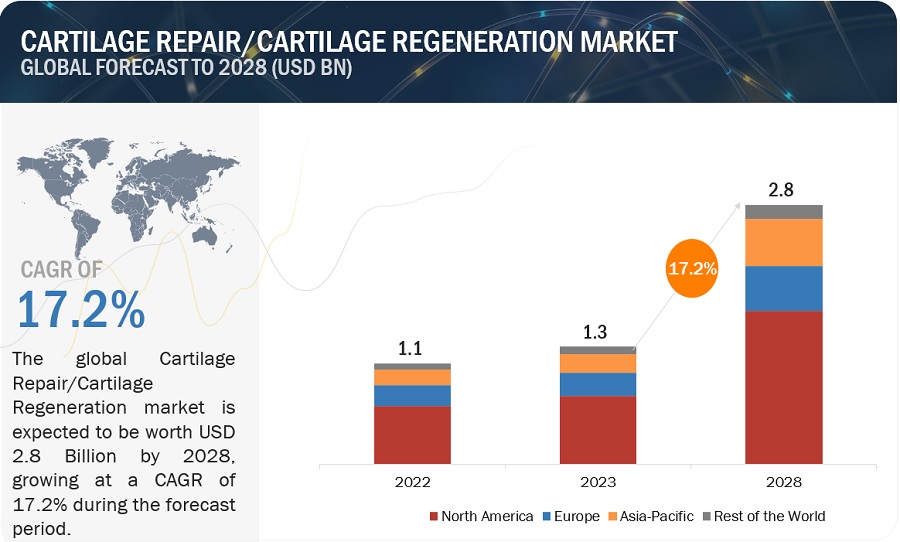The cartilage repair and regeneration market is rapidly evolving, driven by advances in medical research and technology. Cartilage, a resilient and smooth elastic tissue, plays a critical role in the body by covering and protecting the ends of long bones at the joints. However, its limited capacity for self-repair poses significant challenges when it is damaged due to injury, wear and tear, or diseases such as osteoarthritis. This article delves into the market dynamics, focusing on the cutting-edge treatment modalities, particularly cell-based therapies, that are revolutionizing cartilage repair and regeneration.
Market Overview
The global cartilage repair and regeneration market is experiencing significant growth, underpinned by the increasing prevalence of joint disorders and the rising geriatric population. According to recent market research, this market is expected to continue expanding at a robust pace over the next decade. The market is segmented based on treatment modalities, with cell-based therapies emerging as a dominant segment due to their potential to effectively restore cartilage function.
Cartilage Repair/Cartilage Regeneration Market by Treatment Modalities (Cell-Based (Chondrocyte Transplantation, Stem Cells, Growth Factors) – Global Forecast to 2028
Download a PDF Brochure: https://www.marketsandmarkets.com/pdfdownloadNew.asp?id=37493272
Treatment Modalities
Cell-Based Therapies
Cell-based therapies are at the forefront of cartilage repair and regeneration. These therapies involve the use of living cells to replace or repair damaged cartilage. The main cell-based treatment modalities include:
a. Chondrocyte Transplantation
Chondrocyte transplantation, particularly Autologous Chondrocyte Implantation (ACI), is a well-established method. ACI involves harvesting healthy chondrocytes from the patient’s own cartilage, expanding them in vitro, and then re-implanting them into the damaged area. This approach leverages the patient’s own cells, reducing the risk of immune rejection and enhancing the integration and functionality of the repaired cartilage.
- Traditional ACI: The traditional method involves a two-step surgical procedure. Initially, healthy cartilage is harvested arthroscopically. The chondrocytes are then cultured for several weeks before being implanted into the damaged area through an open surgery.
- Matrix-Induced Autologous Chondrocyte Implantation (MACI): This newer technique embeds the chondrocytes onto a biodegradable scaffold, which is then implanted into the defect. MACI simplifies the surgical procedure and improves the distribution and retention of chondrocytes at the repair site.
b. Stem Cells
Stem cell therapy is a promising frontier in cartilage regeneration. Stem cells, particularly mesenchymal stem cells (MSCs), have the ability to differentiate into various cell types, including chondrocytes, under the right conditions. This potential makes them ideal for repairing cartilage damage.
Bone Marrow-Derived MSCs: These stem cells are typically harvested from the patient’s bone marrow, expanded, and then injected into the damaged cartilage area. They not only promote the regeneration of cartilage tissue but also modulate the inflammatory environment, potentially slowing the progression of degenerative joint diseases.
Adipose Tissue-Derived MSCs: Another rich source of MSCs is adipose (fat) tissue. These cells can be obtained through a minimally invasive liposuction procedure. Adipose-derived MSCs have shown significant promise in clinical trials for cartilage repair due to their high proliferative capacity and chondrogenic potential.
c. Growth Factors
Growth factors are proteins that play crucial roles in cell proliferation, differentiation, and tissue regeneration. In cartilage repair, growth factors such as transforming growth factor-beta (TGF-β), insulin-like growth factor (IGF), and bone morphogenetic proteins (BMPs) are used to enhance the repair process.
Platelet-Rich Plasma (PRP): PRP therapy involves concentrating the patient’s own platelets and injecting them into the damaged area. The growth factors released from platelets can accelerate tissue repair and reduce inflammation, contributing to cartilage regeneration.
Recombinant Growth Factors: These are synthetically produced growth factors that can be directly applied to the damaged cartilage. Their application aims to mimic the natural regenerative processes and support the formation of new cartilage tissue.
Market Drivers
Several factors are propelling the growth of the cartilage repair and regeneration market:
- Increasing Incidence of Joint Disorders: The rising prevalence of osteoarthritis and sports-related injuries is driving the demand for effective cartilage repair solutions. Osteoarthritis, characterized by the degeneration of joint cartilage, is a leading cause of disability worldwide.
- Advancements in Biotechnology: Innovations in biotechnology and tissue engineering are facilitating the development of more effective and less invasive treatment options. Techniques such as gene editing and 3D bioprinting are opening new avenues for cartilage regeneration.
- Aging Population: The global increase in the elderly population, who are more prone to joint disorders, is significantly boosting the market. Older adults often experience cartilage wear and tear, necessitating advanced repair solutions.
- Rising Awareness and Healthcare Expenditure: Growing awareness about the benefits of early intervention and the increasing availability of healthcare resources are encouraging more patients to seek treatment for cartilage damage.
Challenges and Future Prospects
Despite the promising advancements, the cartilage repair and regeneration market faces several challenges:
- High Costs: Advanced treatments, particularly cell-based therapies, can be expensive, limiting their accessibility to a broader patient population.
- Regulatory Hurdles: The stringent regulatory framework for the approval of new therapies can slow down the introduction of innovative treatments to the market.
- Variability in Treatment Outcomes: The effectiveness of cartilage repair treatments can vary significantly among patients, influenced by factors such as age, severity of damage, and underlying health conditions.
Looking ahead, ongoing research and clinical trials are expected to address these challenges and further enhance the efficacy and affordability of cartilage repair therapies. The integration of personalized medicine approaches and the development of off-the-shelf allogeneic cell products are likely to revolutionize the market.
Conclusion
The cartilage repair and regeneration market is poised for substantial growth, driven by the increasing need for effective treatments for joint disorders. Cell-based therapies, including chondrocyte transplantation, stem cell therapy, and growth factor application, are leading the way in this dynamic field. As research progresses and new technologies emerge, the potential to restore joint function and improve the quality of life for millions of patients continues to expand, marking a new era in orthopedic medicine.

Leave a comment